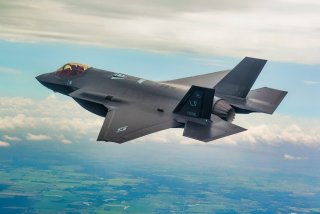F-35: Still the Most Capable Combat Aircraft if it Can’t Be Used in Combat?
The Lockheed Martin F-35 Lightning II program has faced significant hurdles with its Block 4 upgrades, leading the U.S. Department of Defense (DoD) to halt acceptance of new jets until issues are resolved.
Summary: The Lockheed Martin F-35 Lightning II program has faced significant hurdles with its Block 4 upgrades, leading the U.S. Department of Defense (DoD) to halt acceptance of new jets until issues are resolved. The Block 4 upgrade, part of the Technology Refresh-3 (TR-3), is designed to enhance the aircraft's weapons capacity, target recognition, and electronic warfare capabilities. However, concurrency problems—where development and procurement occur simultaneously—have caused delays, complicating testing and implementation. As a result, the full combat capability of the F-35 won't be realized until at least 2025, with some capabilities deferred to the 2030s. Despite these challenges, the Pentagon may resume accepting F-35s with an interim TR-3 software version for training purposes. Meanwhile, the F-35 program's total cost is now expected to exceed $2 trillion, reflecting inflation and prolonged service timelines.
F-35 Lightning II Faces Delays in Block 4 Upgrades, Pushing Full Combat Capabilities to 2025 and Beyond
Last July, the United States Department of Defense (DoD) announced that it would halt acceptance of the Lockheed Martin F-35 Lightning II until the Block 4 upgrades were completed. That update, part of the Technology Refresh-3 (TR-3), was intended to allow the fifth-generation stealth fighter to carry more weapons, better recognize targets, and improve its electronic warfare capabilities.
In December, F-35 program executive officer Lt. Gen. Michael Schmidt said in written testimony to the House Armed Services subcommittee that there were serious “concurrency problems.” That is when a system moves through development and into procurement at the same time, which makes it harder to fix problems discovered in testing. The issues were so great that the Pentagon was willing to wait for the issues to be resolved before it accepted any additional Lightning IIs.
However, the Block 4 upgrade might not be available for another twelve to sixteen months—and that’s an optimistic estimate. The DoD may be forced to resume accepting delivery this summer, Schmidt told lawmakers on Tuesday.
“I am as frustrated as you that I can’t nail down a specific date and be extremely clear about exactly when we will deliver,” Schmidt explained during a House Armed Services Tactical Air and Land Forces Subcommittee. This is the “best chance” the program has to accept the F-35s before TR-3 is fully finished, he said.
The U.S. military would receive the jets with an interim version of the TR-3 software—one described as having a “staple” and “capable” code that could be used in training. However, the full combat capability for the F-35s won’t arrive until sometime in 2025.
“We are looking at everything we can to try to figure out what if we move left in that, but that is an accurate assessment: for a couple of the capabilities that our warfighters feel are required to be fully combat-capable, they will not be there at the truncation,” Schmidt added.
As previously reported, in 2023, Lockheed Martin built approximately 158 F-35s of all versions, but it delivered only ninety-eight of those aircraft and stored up to sixty jets until the TR-3 software update is ready.
It was also earlier this year that the Pentagon approved full-scale production, marking a significant milestone for the program—while Lockheed Martin has some 3,500 orders across all three versions of the aircraft.
Full Block 4 Capabilities Coming Later Than Expected
While the Pentagon could begin to receive slightly updated F-35s this summer, with additional upgrades coming in a year or so later, an independent review conducted last year determined that “numerous Block 4 capabilities will not deliver until the 2030s.”
The Block 4 update will not focus on delivering the “must-have content” according to Schmidt, which will include an undefined “subset” of eighty-eight capabilities originally part of the Block 4 plan.
“Future risks hinge upon whether TR-3 will require additional incremental software releases to test and implement critical fixes. If risk manifests in labs or flight test, TR-3 may require additional software releases (taking between two and six weeks per release),” Schmidt wrote in his testimony.
It is important to note that the TR-3 doesn’t affect jets already in the U.S. inventory, but it could present problems with future aircraft—namely, that they won’t be combat-capable. This will require compromises, and it is unclear if even that will solve all of the issues.
“Reimagined Block 4 will likely include common capabilities for electronic warfare; communication, navigation, and identification; sustainment, and new weapons for the partnership, plus U.S. service-unique capabilities and partner-unique capabilities. Reimagined Block 4 must consist of ‘what industry can actually deliver’” across the Future Years Defense Program and be consistent with the JESB-directed development funding cost cap,” Schmidt also wrote.
Is the F-35 still the most capable combat aircraft if it can’t be used in combat, or if its upgrade needs to be vastly truncated? It was also this week that the Government Accountability Office warned that the lifetime cost of the F-35 Lightning II is now projected to exceed $2 trillion, a rise attributed to inflation and extended service expectations through 2088.
Author Experience and Expertise: Peter Suciu
Peter Suciu is a Michigan-based writer. He has contributed to more than four dozen magazines, newspapers, and websites with over 3,200 published pieces over a twenty-year career in journalism. He regularly writes about military hardware, firearms history, cybersecurity, politics, and international affairs. Peter is also a Contributing Writer for Forbes and Clearance Jobs. You can follow him on Twitter: @PeterSuciu.
You can email the author: [email protected].

